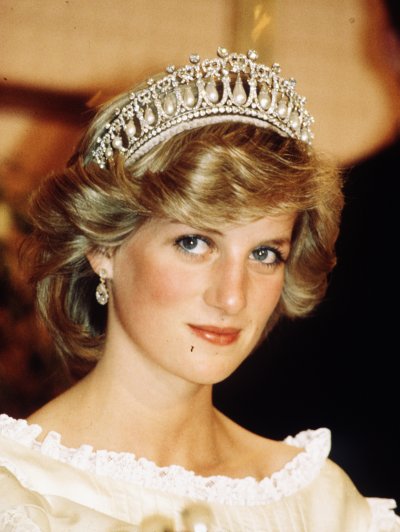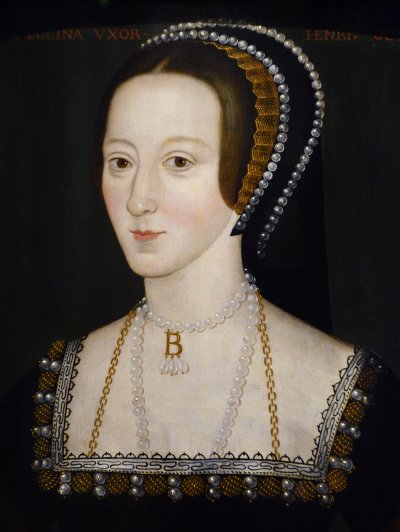While it should be noted that Spencer is a stunning film, it isn't without its flaws—most notably its bizarre reference to Henry VIII's wife, Anne Boleyn.
Starring Kristen Stewart, Pablo Larraín and Stephen Knight's movie focuses on three days in the life of the late Diana, Princess of Wales.
Across 2 hours, the audience is hooked, desperately trying to anticipate Diana's every move. Knight's imagining of her inner psyche, her isolation from her 'family,' her loving bond with her sons William and Harry (the only two people who seem to understand her), and her friendships with the staff at Sandringham, portray Diana not as a princess, but as a human being.
However, in a very different, unique take, Knight makes interesting comparisons to one of the most misjudged women in history—Anne Boleyn, the former Queen of England who was married to King Henry VIII. The appearance of Anne at Diana's most desperate moments in Spencer stirs a sense of intrigue and bewilderment simultaneously. Not to mention, the appearance of Boleyn can be pretty jarring, often shattering viewers' absorption in the story.
In Spencer, it is suggested the all-seeing all-hearing equerry major Alistair Gregory (Timothy Spall) planted the book "The Life and Death of Martyr" by Eric Ives in her bedroom. Whether it was by coincidence or a bid to taunt Diana, it is unclear. Either way, Diana proceeds to read the book and begins having hallucinations of Anne Boleyn. There is even a point where Diana and Anne morph into one another (yes, really).
Anne's inclusion in Spencer suggests that the spirit of the beheaded queen lives on and history may be repeating itself through Diana. However, in reality, the comparison to Anne Boleyn in Spencer was tenuous at best.
For those who may be a little confused about the Boleyn subplot, the comparison between her and Princess Diana does, to an extent, make sense. For example, both women's marriages were strained, they became highly influential figures, and both were daughters of earls who married into royalty. Also, another eery similarity is that Anne Boleyn's sister Mary was King Henry VIII's mistress. Diana's elder sister Lady Sarah Spencer (now McCorquodale), meanwhile, dated Prince Charles.
With all that being said, though, when you take a closer look at their lives, they were really quite different.
One of the key differences is that while Anne was married to the King of England, Henry VIII, and became the Queen of England after a complicated process to get their marriage officially accepted (sorry, Catherine of Aragon), Diana married Prince Charles, the heir apparent to the British throne, who is still yet to be crowned King to this day.
It is true, both Anne and Diana's marriages were plagued by rumors of infidelity, with affairs on both sides eventually transpiring. Anne and Henry married on January 25, 1533, and on September 7, 1533, Anne gave birth to the future Queen Elizabeth I. After three miscarriages and failing to produce a male heir, by March 1536, Henry was courting Jane Seymour, who would go on to become his third wife just 10 days after Anne's execution in May 1536 (more on that later).
Anne was also rumored to have had several lovers, including Henry Percy and Sir Thomas Wyatt, although this has never been proven.
As for Diana, Prince Charles had always been romantically linked to Camilla Parker Bowles. Diana even famous stated in a BBC Panorama interview with Martin Bashir in 1995, that "there were three of us in this marriage, so it was a bit crowded," referring to Charles' relationship with Parker Bowles.
Diana herself was subject to infidelity rumors, most famously Major James Hewitt. In the same BBC interview, in response to Hewitt's claims they had an affair, Diana confirmed the rumors stating they had "gone beyond a close friendship." When asked if she had been unfaithful, Diana said: "I adored him. Yes, I was in love with him. But I was very let down."


Diana and Charles separated and officially divorced in August 1996. Like Henry VIII, Charles remarried, tying the knot with Parker Bowles in April 2005.
Author Annabelle Sandstone, who does not believe Anne and Diana to be similar, explained to Newsweek: "Anne was centuries ahead of her time: she was a modern woman in her expectations of what she could achieve as a woman but she did not have the skills to rein in her thoughts and keep her temper under control.
"Perhaps that's where she and Diana are similar: they both expected their husbands to be faithful and could not keep quiet when they were not. We understood it when Diana did it and was appalled on her behalf. No one had that same sympathy for Anne: she was an upstart who had left the sphere to which she was born. Meritocracy was only just about acceptable for men."
Unfortunately, both Anne and Diana's lives did come to a tragic end, but under entirely different circumstances.
Anne had been charged with adultery, incest, and high treason. She had been suspected of having sexual relations with five other men, including her brother George. With her lovers, it was suspected Anne had conspired to overthrow her husband. Under the Treason Act of Edward III, adultery on the part of a Queen was a form of treason, for which the penalty was execution. Anne was beheaded at the Tower of London on May 19, 1536.

Sadly, Diana's life also ended in tragedy, when she was killed in a car crash in the Pont de l'Alma tunnel in Paris on August 31, 1997.
Her rumored partner Dodi Fayed and the driver of the car, Henri Paul, were also killed in the collision. Diana's bodyguard, Trevor Rees-Jones, survived the crash.
Discrediting several conspiracies surrounding Diana's death, a 2004 Metropolitan police investigation known as Operation Paget concluded there was no evidence of a conspiracy to murder the Princess of Wales or Dodi Al-Fayed.
Despite all of their differences, both women will indeed be remembered as two of the most influential women in British history. Anne became a figurehead of the English Reformation and Diana became an international icon commonly referred to as "The People's Princess." She was famed for her high-profile charity work, her impeccable fashion sense, as well as her relatability.
But ultimately, Anne became Queen and suffered an unimaginable fate at the hands of her husband, whereas Diana veered from that path entirely. She was independent, strong, and influential. Sure, there are some surface-level similarities but both women lived entirely different lives, with Diana taking control of her narrative and leaving the life of a royal behind her.
Spencer is in theatres now.
Uncommon Knowledge
Newsweek is committed to challenging conventional wisdom and finding connections in the search for common ground.
Newsweek is committed to challenging conventional wisdom and finding connections in the search for common ground.
About the writer
Molli Mitchell is a Senior SEO TV and Film Newsweek Reporter based in London, UK. Her focus is reporting on ... Read more





